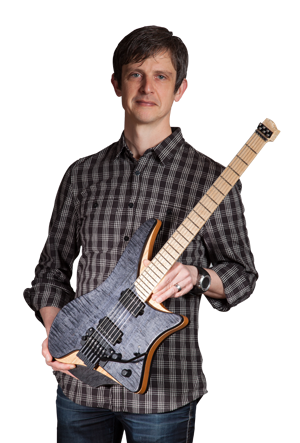I managed to create a prototype bridge today. The final design will require some tweaks for sure, but I think it will work. I have gone through a million ideas ranging from close to the original Ned Steinberger patent to the Atlansia design. I am not sure how Atlansia have solved fastening the string, but it might be similar to what I have done. Another thought entails using the Steinberger design but not lock the string, but route it through the body and using the tuner to pull the string in a “bow” shape. I am still thinking about that, but until then, here are some pictures of the progress so far:
Obviously, this is just a rough proof-of-concept. It has taught me several valuable lessons that will make the final product much easier to make. The knob will be knurled and the threads will be finer (this is M6x0,75) Next: find someone with good enough machines to work with stainless steel… And not charge an arm and a leg for it…












Originally posted 2001-01-07:
Congratulations on the new blog. It’s looking good.
I moved my comment from the old blog here:
That’s really impressive. How did you make the hollow threaded rod? It seems like very delicate work making a slot in it.
Actually, progress pictures and descriptions of all the components would be interesting to see.
BTW, does it have to be stainless steel? Wouldn’t brass do? And are thread cutting tools available with finer thread than 0,75 unless you use smaller diameter rods (which will be even more delicate and difficult to work with)?
/Alex
Hi Alex,
The hollow threaded rod is just a bolt that I cut and drilled a hole in. I then put it in the lathe and made the slot.
There are thread cutting tools for M6x0,5 and M8x0,5 – the same pitch as M3 regular threads. This should make it easy.
The idea of stainless steel was for looks and durability. Brass is much easier to machine but would require treatment of the surface to make it look nice. I am actually considering aluminium for the non-moving parts. I got the new Stewart Mac Donald catalog yesterday and it seems that more and more bridges are using non-traditional materials, so I might give that a go.
How are things going with your guitar? I am considering bolting to “L” beams upside down next to each other to make a “T”.
Hi Ola
Sounds easy with the drilling. I just bought a drill press, so I think I’ll try that myself. Not that I’m about to make tuners right now, but it’s nice to know what can be done with my current equipment and skills.
I acually like the look of worn and oxidized brass in many circumstances, but it certainly doesn’t work for all kinds of design. BTW, I bought my aluminium and brass pieces at metallstore.de. They were the best online retail metal shop I could find (and I found absolutely no physical shops near where I live (Denmark), that could sell me what I needed). If you know of better sources of different metals in various forms, please share the knowlegde.
As for my own guitar build… thanks for asking. Things aren’t really progressing these days. I’ve been much too busy and occupied with other aspects of life. One of the obstacles, come to think of it, was the fact that I was unable to print 1:1 engineering drawings from my sketchup models. I see that you have some very fine drawings, so if you know of a good and free program for making such drawings (perhaps even one that can import sketchup (.skp) files), please let me know.
It sounds like a good idea with the two L-beams making a T-beam. It would give a thick and strong bottom flange, which is where the strength is really needed. I decided against it for my own build, because the seam between the two beams would be visible on the body of the guitar (the beam is a “neck through” on my design). But for a neck only, it’s not that much of an issue.
/Alex
Hi Alex,
I am using Visio for my drawings. It is a tool that I use often enough in my professional life, but for creating presentations in those instances.
I am incredibly impressed with SketchUp. I have used it earlier when I was renovating my house and wanted to see what an extension and a new entrance would look like. I don’t have the patience to learn it well enough to do what you are doing though… I wish I did. I believe you can export a 2-D rendiiton as a PNG to import into some other tools.
For the body shape, I used Adobe Illustrator that I then exported as an SVG (Scalable Vector Graphics). Talk about a tool with a learning curve! I hated it, but it did the job.